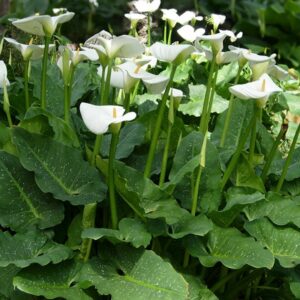Your cart is currently empty!
Unveiling the Enchanting Red Calla Lily Bulbs: A Comprehensive Guide

Introduction
Red calla lily bulbs, renowned for their striking blooms and elegant foliage, have captivated gardeners and graced gardens worldwide. These captivating plants, scientifically known as Zantedeschia aethiopica, are native to South Africa and belong to the Araceae family. With their trumpet-shaped flowers and glossy leaves, red calla lilies bring a touch of exotic beauty to any landscape. This comprehensive guide will delve into the fascinating world of red calla lily bulbs, exploring their characteristics, cultivation requirements, care tips, and more.
Characteristics
Flowering and Bloom Period
Red calla lilies are renowned for their distinctive trumpet-shaped blooms that emerge from a fleshy, pointed structure called a spathe. The spathe, which resembles a flower petal, can vary in color, but in the case of red calla lilies, it typically ranges from deep scarlet to burgundy. The blooming period for red calla lilies generally extends from late spring to early summer, captivating observers with their vibrant display.
Height and Spread
These majestic plants can reach impressive heights, with some varieties growing up to 3 feet tall. Their foliage also contributes to their stature, with long, sword-shaped leaves that add a graceful touch to the garden. The overall spread of red calla lilies can vary depending on the cultivar, with some varieties exhibiting a more compact growth habit than others.
Cultivation Requirements
Climate
Red calla lilies thrive in warm and humid environments, similar to their native South African habitat. They prefer temperatures ranging from 65 to 85 degrees Fahrenheit and can tolerate partial shade to full sun. However, it’s important to protect them from extreme temperatures, particularly frost, as they are not cold-hardy.
Soil
These plants prefer moist, well-drained soil that is rich in organic matter. Soil pH should be slightly acidic, around 6.0 to 6.5, to encourage optimal growth and flowering. Amending the soil with compost or manure can help improve its fertility and drainage capabilities.
Planting
Red calla lily bulbs should be planted in the spring after the last frost has passed. Choose a planting site that receives adequate sunlight or partial shade and prepare the soil as mentioned above. Dig a hole that is approximately 3-4 inches deep and 6 inches wide. Place the bulb in the hole with the pointed end facing up and cover it with soil, gently firming it around the bulb. Water the newly planted bulb thoroughly and keep the soil moist but not waterlogged.
Care Tips
Water and Fertilizer
Red calla lilies require regular watering, especially during the growing season. Allow the top 2-3 inches of soil to dry out between waterings to prevent overwatering. Fertilize the plants monthly during the growing season with a balanced liquid fertilizer to promote healthy growth and abundant blooms.
Mulching and Weed Control
Mulching around the plants with organic materials such as shredded bark or compost helps retain moisture, suppress weeds, and regulate soil temperature. Regular weeding is also essential to prevent competition for water and nutrients.
Support
As the plants grow taller, they may require support to prevent the stems from bending or breaking. Trellises or stakes can be used to provide additional support, especially in windy conditions.
Troubleshooting
Common Pests and Diseases
Red calla lilies are generally resistant to pests and diseases, but they can occasionally be affected by aphids, spider mites, or thrips. Regularly inspect the plants for signs of infestation and treat them promptly with appropriate pesticides. Additionally, practicing good sanitation techniques, such as removing infected plant material and avoiding overhead watering, can help prevent the spread of diseases.
Dormancy
After the flowering period, red calla lilies enter a dormant phase, typically during the fall and winter months. During this time, the leaves will yellow and die back, and the plant will go through a resting period. It’s important to reduce watering during dormancy and allow the soil to dry out slightly. Once spring arrives, gradually increase watering to encourage new growth.
Propagation
Red calla lilies can be propagated through division or by planting the bulb offsets that form around the base of the mother plant. Division should be done in the spring when the plants are dormant. Carefully dig up the clump of bulbs and separate them, ensuring that each division has a portion of the rhizome attached. Plant the divisions in well-prepared soil and water deeply. Bulb offsets can be planted directly into the ground or started in containers and transplanted later.
Conclusion
Red calla lily bulbs offer a captivating addition to any garden, bringing a touch of exotic beauty and elegance. With their striking blooms, graceful foliage, and relatively easy care requirements, these plants are well-suited for both experienced gardeners and beginners alike. By adhering to the cultivation and care tips outlined in this guide, you can successfully cultivate vibrant and flourishing red calla lilies that will enhance your garden’s splendor for seasons to come.








Leave a Reply